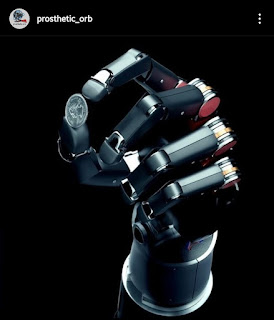699
Science is often viewed as something done by researchers in lab coats in a pristine lab setup. While it is true in some cases, scientific advances happen when scientists and their findings interact with society.
In this new series, we will speak to people who work closely with the public and bring science to them. The focus of this series will be exploring the not-so-popular areas of science.
 |
| Advanced upper limb hand prosthetic Image credit: Prosthetic Orb |
For the first interview, we spoke to Elegencs Peter, a certified prosthetist, and orthotist. Hailing from Raipur, the capital of the central Indian state of Chattisgarh, Peter has a bachelor’s degree in Prosthetics and Orthotics from the Mobility India Rehabilitation Research and Training Centre in Bengaluru. Through his podcast, Prosthetic Orb, Peter connects the science of prosthetics with the society at large.
 |
| Elengencs Peter |
Coffee Table Science spoke to Peter over email and the interview has been edited for clarity.
CTS: For the lay audience, what is the difference between prosthetics and orthotics?
Elegencs Peter: Prosthetics refers to the study of artificial devices which help to restore the functionality of a lost limb. Prosthesis refers to the actual artificial devices which are used by the patient.
Orthotics refers to the study of devices that are used by the patient to accommodate any deformity with the limbs. Orthosis refers to the actual devices that are used by the patients.
Why are these devices important?
These devices has a tremendous impact on the quality of life of the patients. For example, when a person loses their upper limb, simple daily activities such as buttoning up a shirt or any activities that require two-hand coordination become challenging.
When patients start using a prosthesis they are able to get back to their normal activities like just before the amputation. The same goes for the lower limb amputee who loses the ability to walk. When provided with a prosthesis they are able to walk again without any support.
There are also a lot of people who have some kind of weakness in the limb. Conditions like Post Polio Residual Paralysis (PPRP) or muscular dystrophy due to which they are unable to walk properly or have pain. In these situations, orthosis can be used to restore their function or relieve pain.
How have these developed over the years?
The earliest noted date of a prosthesis being used is between 950-710 B. C. Made up of leather, the prosthesis was for a toe. Major improvements in the materials came during or after the Second World War. During this period a combination of metal bars and leather was used. Towards the early 2000s, polymers came into the play for the fabrication of prosthetic and orthotic devices with the implementation of biomechanics. With involvement of technologies like 3D printing and bio integration, the designs have improved dramatically and even the materials being used offer more comfort.
New technologies always lead to improvements in these devices. But they also come at a cost. What can be done to make these devices more affordable to people who need them?
In my opinion, we have to balance the costs and the functionality for each patient. What I do while I prescribe any prosthesis or orthosis is take into consideration of the financial situation of the patients.
This is still a rather niche field. Once awareness about the devices increases, the markets become larger and that paves way for price reductions. Currently there are government programs that can be used by the people in need to avail the prosthetic and orthotic services. Government programs can vary by state and it would help to contact a local government departments to know what facilities are available in the region.
Is the medical fraternity well versed with options that are available to amputees?
Sadly no. I have met many medical professionals who are unaware of this field which leads to limitations in the treatment options for the amputees.
What is lacking in the field in India today? What are the challenges and what is needed to overcome them?
Awareness. Most people know about medicine, dentistry or even physiotherapy. But they don’t have any idea about prosthetics and orthotics. The field lacks the exposure it deserves and how it can help the people in need.
One of the challenges is that there are many misconceptions about the field. Most of the information is not easily accessible to people or available in medical jargon, which is difficult to understand.
To overcome this, I started a podcast called Prosthetic Orb where we release bite-sized content related to the field. It also provides a platform for other professionals to talk about the field and new advances that can be implemented.
How can a good Samaritan contribute to this cause?
People can talk about about this field to nearby hospitals, doctors and other medical professionals in their circle and encourage students to keen on pursuing medical education to explore this field as well. They can also engage actively by sharing information and resources in this domain to those in need and let them know that there is a way.
Interested readers can also follow Prosthetic Orb on Instagram




